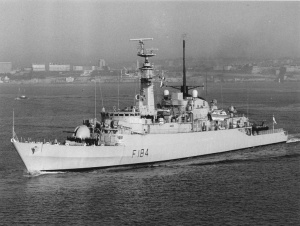HMS Ardent (F184)
 |
|
| History | |
|---|---|
|
|
|
| Name: | HMS Ardent |
| Operator: | Royal Navy |
| Ordered: | 17 April 1973 |
| Builder: | Yarrow Shipbuilders |
| Laid down: | 26 February 1974 |
| Launched: | 9 May 1975 |
| Commissioned: | 13 October 1977 |
| Homeport: | HMNB Devonport |
| Identification: | Pennant number: F184 |
| Motto: | Through fire and water |
| Fate: | Sunk by Argentine aircraft on 22 May 1982 |
| General characteristics | |
| Class and type: | Type 21 frigate |
| Displacement: | 3,250 tons full load |
| Length: | 384 ft (117 m) |
| Beam: | 41 ft 9 in (12.73 m) |
| Draught: | 19 ft 6 in (5.94 m) |
| Propulsion: |
|
| Speed: | 32 knots (59 km/h; 37 mph) |
| Range: |
|
| Complement: | 177 |
| Armament: |
|
| Aircraft carried: | 1 × Westland Wasp helicopter, later refitted for 1 × Lynx |
HMS Ardent was a Royal Navy Type 21 frigate. Built by Yarrow Shipbuilders Ltd, Glasgow, Scotland. She was completed with Exocet launchers in 'B' position.Ardent took part in the Falklands War, where she was sunk by Argentine aircraft in the Falkland Sound on 21 May 1982.
On 19 April 1982 Ardent sailed from HMNB Devonport near Plymouth for the Falkland Islands. On route, she escorted task force ships that had left late, on their way to Ascension Island, arriving on 3 May and sailing on the morning of the 7 May. On 9 May 1982 while 700 miles south west of Ascension, Ardent closed to within 200 yards of the starboard side of the troopship Canberra and provided a gun power demonstration to the troops sailing south.
On 21 May 1982, whilst lying in Falkland Sound and supporting Operation Sutton by bombarding the Argentine airstrip at Goose Green, Ardent was attacked by at least three waves of Argentine aircraft. The air strikes caused Ardent to sink the next day.
The first attack took place when a lone A-4 Skyhawk dropped two bombs at 16:00 Z (UTC), which straddled the frigate but both failed to explode.
The bulk of the air strikes began at 17:40 Z. Ardent was ordered to proceed west of North West Island along with Yarmouth to "split air attacks from the south". A group of three aircraft, either Skyhawks or IAI Daggers crossed the Falklands Sound from the west and then turned to their left to attack from the north east. Cannon fire and three bombs struck home as the Argentine aircraft pressed their attack from the port side. The only defensive weapons which reacted properly were the 20 mm AA cannons.
...
Wikipedia
